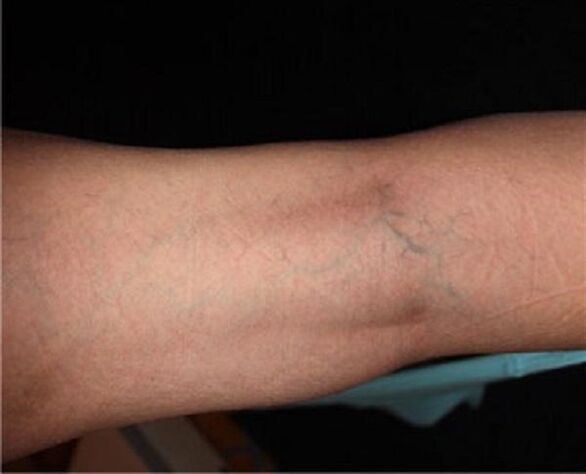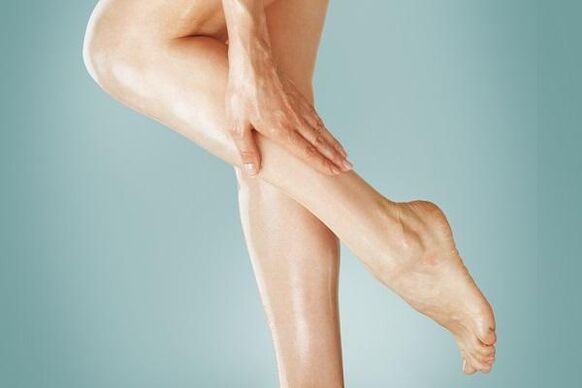Pathological changes in the structure of the venous vessels cause a varicose veins, as a result of which their patency, elasticity worsen and the walls of the walls and the formation of specific nodes occurs.
Several types of varicose veins are distinguished:
- lower extremities;
- rectum;
- seed cord;
- small pelvis.

In everyday life, the expression "varicose" was firmly settled, but in official medicine there is no such thing and diagnosis, since we are talking about varicose veins.
Symptoms and signs
The disease spreading to the lower limbs is accompanied by symptoms:
- the formation of varicose veins, which are issued above the surface of the skin, representing nodal seals;
- Swelling in the legs, accompanied by a feeling of severity, which is concentrated in the area of the ankles. Often becomes a consequence of a long load during the day and manifests itself in the evening;
- Periodic pain in the legs appears;
- From time to time, convulsions in the calf muscles and the feeling of running goosebumps are concerned, usually at night;
- The late stage is distinguished by pronounced trophic disorders of the skin of the lower third of the lower leg: pigmentation, seal, dermatitis and as an extreme manifestation - a trophic ulcer.
The consequence of the development of varicose veins of the rectum, is the appearance of hemorrhoids. He is accompanied by the following symptoms:
- itching, burning, discomfort in the anus, especially intensifying after drinking alcohol, taking a bath or physical activity;
- bleeding in the later stages of varying degrees of intensity;
- Inflammation and loss of hemorrhoids.
Stages
The development of varicose veins of the lower extremities passes three stages.
Important! In the early manifestations of varicose veins, the role of medical and preventive measures is important, during their implementation, the chance of preventing the further development of the disease increases significantly.
Varicosis at the early stage of manifestation is evidenced by the feeling of severity, swelling, aching pain in the legs. During this period, it is necessary to immediately begin preventive measures: a massage course, swimming, the use of special legs, since all this is effective to prevent the development of varicose veins only at first.
- Stage I. The appearance of severity in the legs, their edema, characteristic aching pains, the formation of vascular stars, knotted veins, which are visible through the skin. Cramps in the legs and burning in the IKR and Stop area can be added to this.
- Stage II. A significant increase in the size and number of nodes and stars, which become more noticeable. The swelling of the legs is more pronounced. Strengthening the pain syndrome.
- Stage II. Changing the structure of the surface of the skin - the appearance of dryness, age formations. A significant increase in venous nodes, thinning of the walls of blood vessels, which increases the risk of bleeding even with slight injury.

Complications (consequences) of varicose veins
Varicose disease can lead to serious complications. At the last stage of the development of varicose veins, the extreme thinning of the walls of the vessels is observed, in this regard, the risk of trophic ulcers - open poorly healing wounds on the vessels that occur even with minor trauma.
The result of the rupture of the varicose node is the development of thrombophlebitis. During the appearance, which the formation of thrombosis occurs with inflammation of the vein wall and a blood clot forms, which covers its lumen.
With the development of acute thrombophlebitis, severe pains appear in the area of thrombped veins, and the body temperature, accompanied by chills, rises. With thrombophlebitis of superficial veins, painful seals with redness of the skin along the veins are characteristic. Thrombophlebitis of deep veins is accompanied by edema of the limbs due to a sharp violation of the venous outflow.
Varicose veins in women
Many women face varicose veins. This is due to the predisposition of women to the disease due to the characteristics of the female hormonal system. In addition, pregnancy and childbirth in most cases become the causes of varicose veins, since there is an effect of increased load and increased blood flow to the pelvic organs. In addition to varicose veins of the lower extremities in women, varicose veins in the perineum, affecting the external genitalia, often develops, which is a consequence of the congenital or acquired weakness of the vascular wall and valve insufficiency. The effect of external (prolonged static stress, significant physical activity) or internal factors (excess body weight, disease of the pelvic organs in a chronic form) leads to the formation of varicose veins.
Important! The issue of the influence of oral contraceptives and hormone replacement therapy remains open.
The development of varicose veins during pregnancy
The bearing of each subsequent pregnancy sharply increases the chances of developing venous insufficiency in women and the formation of varicose veins. This is due to hormonal changes in the body of a woman and a significant increase in the load on the veins. The main task of a woman during this period is the observance of preventive measures in order to avoid the development of varicose veins. If there is a predisposition and there are signs of the initial development of varicose veins, consultation and observation of a phlebologist is necessary on all pregnancy. Preventive measures should be supplemented by the wearing of compression linen, in some cases it must be dressed for the period of childbirth. For this, special models are available.
Varicose veins in men
Varicose disease is often found in men in the form of varicocele - varicose veins of the seed cord. Symptoms of the disease:
- soreness in the testicle and a sense of heaviness, a scrotum, along the seed cord, which intensifies with physical exertion and prolonged standing;
- During the palpation of the scrotum, the crowd veins of the seed cord are determined.
The development of varicocele causes male infertility due to circulatory disorders and concomitant pathological changes in the normal operation of the testicles:
- There is an increase in temperature in the testicle to body temperature. High temperature affects spermatogenesis;
- hypoxia (oxygen starvation, ischemia) of the testicle;
- The accumulation of free radicals in the ovice tissues that violate their activity.
Treatment of varicose veins in men consists of a surgical operation in the presence of indications: pain in the testicle, infertility, aesthetic defect in the scrotum, lack of growth of the affected testicle during puberty. However, the disease can occur asymptomatic and not cause significant discomfort to a man. In adolescents and children, when diagnosing varicocele, surgery is necessary at any stage of the disease, this avoids further development of infertility. Operations are carried out both in the usual open way and endoscopic. It is possible to perform surgical intervention from mini -access and microsurgical testicularization of the testicle.

Varicosis of the pelvis
Varicose veins can occur in the pelvis. In this form, it is found in most cases in women, which is associated with the characteristics of the blood supply to the female body. The expansion of veins causes a sense of pain and severity in the pelvis, which can be caused by a venous stagnation.
The development of varicose veins of the small pelvis occurs for several reasons:
- pregnancy and childbirth;
- change in the shape of the uterus;
- lifting and wearing weights;
- hereditary predisposition;
- lack of physical activity;
- Sedentary work;
- Reception of oral contraceptives.
If there are risk factors and symptoms of the disease, an examination must be undergoing. In the early stages, you can identify varicose veins of the small pelvis with ultrasonic diagnosis. Preliminary diagnosis is also possible for a gynecological examination during the standard procedure. Treatment of the disease includes taking venotonic drugs, wearing special compression linen, and the implementation of medical and preventive gymnastics. It is also necessary to exclude risk factors and is regularly observed in a gynecologist. With the ineffectiveness of conservative methods of treatment, surgical intervention is indicated.
Treatment of varicose veins
Therapeutic measures for varicose veins consist of conservative drug methods of treatment and in the later stages - surgical intervention. In the early stages and at the first signs of varicose veins, intake of enotonics is recommended. As preventive measures, elastic bandaging, wearing compression knitwear and restriction of physical activity at all stages of the disease.
In the later stages, taking drugs and ointments from varicose veins is prescribed:
- improving blood microcirculation;
- increasing venous blood circulation;
- contributing to the unloading of central veins.
The later stages show phlebectomy, surgical removal of pathologically altered veins, as well as sclerotherapy - the administration of special drugs that sclerosis damaged veins, thereby preventing their participation in venous outflow.
It should be noted that we have already written in detail about which compression linen, but at the moment only the surgical method of treatment has established itself as the most effective.

Home treatment
Special gels and ointments can relieve pain in the legs caused by varicose veins. They are unlikely to get rid of varicose veins, given the local effect and weak penetration through the skin, but they will relieve the symptoms of the disease, and relieve the condition. Among the means for external use, groups can be distinguished:
- phlebotonics;
- scorching;
- Anti -inflammatory.
Folk remedies
Recipes of traditional medicine from varicose veins are also used to relieve symptoms and as general strengthening.
Green tomatoes
With the appearance of soreness in the vein region, compresses from green tomatoes help well. To do this, it is enough to take the fetus, cut into slices and lay to the damaged area at night, having previously fixed with a bandage. Green tomatoes contain an antioxidant - lycopine. Due to its effects, not only pain is removed, but also blood circulation improves, and stagnation phenomena are reduced. With regular use, cones formed with varicose veins become less painful and can decrease in volume. You can use ordinary tomatoes in the form of tomato paste for compresses, since it has the highest concentration of lycopene.
Vegetable juices
It is necessary to supplement anti -Varicose therapy with general strengthening agents. As a source of nutrients, freshly squeezed vegetable juices should be consumed daily. Carrot-spinning-selderic Fresh. To strengthen blood vessels, carrot juice is useful, which contains a high concentration of routine - a trace element that helps to strengthen blood vessels. The composition of the juice from spinach leaves is rich in the content of oxalic acid. It carries a cleansing function in relation to the vessels and prevents the formation of blood clots.
Important! Celery is involved in the acceleration of the decay process of fat deposits, removing the products of this breakdown and excess fluid from the body.
- For the preparation of juice, you need to take 10 small carrots, 5 stalks of celery and 5 spinach.
- Skip through a juicer, you can add a little clean drinking water.
Carrot-spinning-berth freesh. Beetroot juice helps to improve blood circulation and blood formation processes, as it stimulates the synthesis of red blood cells, increases the level of hemoglobin and is the prevention of anemia. Prepare in a proportion of 10: 3: 3.
Prevention of the disease
In order to reduce the risk of varicose veins, it is necessary:
- Moderate physical activity, a visit to the pool is especially useful. Swimming has a massage effect, having a beneficial effect on blood vessels without excess load;
- Strengthening the walls of blood vessels using a contrast shower. Complete hygiene procedures with a contrasting shower for the legs. To do this, water your legs for 10 minutes, alternating cold and thermal water;
- Changing the diet - a decrease in oily food, inclusion in the diet of foods rich in routine;
- wearing compression linen, especially with increased physical exertion on the legs;
- Reception of vitamins-mineral complexes, contributing to increasing immunity, strengthening the walls of the vessel and reducing the risk of thrombosis.

Exercises
Prevention and treatment of varicose veins also consist in performing exercises of therapeutic and preventive gymnastics aimed at improving blood circulation and getting rid of signs of blood stagnation. Such exercises are useful to perform on a regular daily basis. You need to start classes with the preliminary preparation of the legs: for this you need to lie on your back by placing your legs on the roller or the back of the sofa. There is 10-15 minutes in this position.
Further, remaining in the position of lying down, proceed to perform exercises:
- bicycle - bending the legs in the knees to imitate the pedals;
- The flexion of the extension of the feet in the ankle joint-the legs are extended, alternately to produce flexion and extensor movements;
- then work in the same way with your fingers;
- Raise your legs at an angle and twisting in the feet and outwards;
- In the lying position, perform the scissors exercise: alternately crossing the legs;
- standing walking in place, while without tearing off socks;
- Remaining in a standing position, we make a rise on socks: on inspiration the top, on exhalation we go down.
Varicose veins develop for a long time, so when the first signs appear, there is a chance to suspend its course. But the only method, complete disposal of varicose veins, remains surgical removal of veins. Be healthy!

















